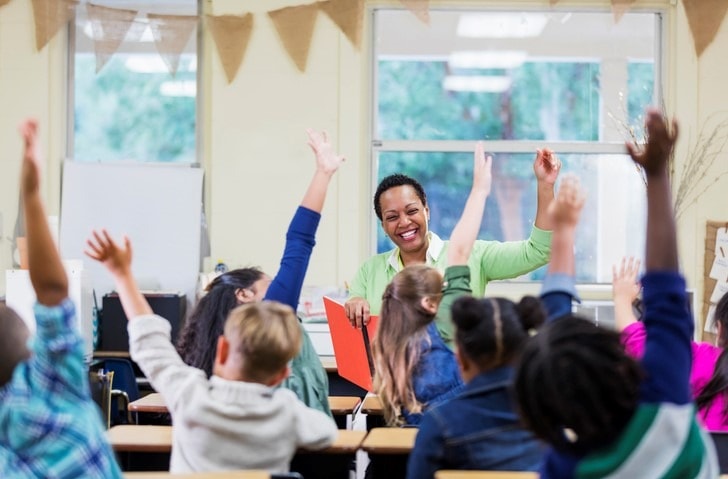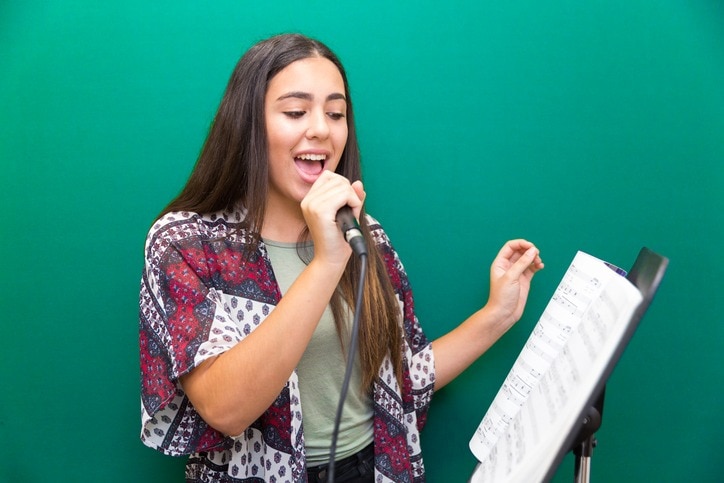/ News Posts / When Students Go Off Track, How Do You Recapture Their Attention?
When Students Go Off Track, How Do You Recapture Their Attention?
Three Music Educators Respond
This article first appeared in the January 2022 issue of Teaching Music.
Cordara Xavier Harper
Doctoral Student in Music Education and Choral Graduate Assistant, University of Memphis, Memphis, Tennessee
To keep a class on track, I rely on my knowledge of the students through the empathy data I gather at the beginning of the semester. Instead of asking my students to shift their attention toward me, I ask them to focus their eyes on me. I use planned, energizing, music-making activities to excite their imagination. None of this is possible without prioritizing my self-care. Even in the most engaging lessons, students may become excited, restless, unfocused, or disengaged over time. Every day is different, and a number of factors can affect student attention. Here are a few tips I’ve learned that help me recapture the attention of my students.
Gather empathy data. Early in the school year, I gather information about my students’ families and cultures. Additionally, I learn my students’ preferred colors, sports, foods, music, and learning styles. It is important for music educators to know their individual learners in the music classroom. In my classroom, I can recapture my students’ attention by singing a student’s favorite lyric. I simply use the information gathered to refocus the attention of students when they go off track. Strategically grouping students and modeling expectations are also helpful strategies. Students enjoy learning from teachers they like. Instead of asking the class to pay attention, I ask for every eye in the classroom or rehearsal space. Students could be paying attention but not looking at the teacher. I ask for eyes because I do not want to assume that just because the students are not looking at me, they are not paying attention.
“Students could be paying attention but not looking at the teacher. I ask for eyes because I do not want to assume that just because the students are not looking at me, they are not paying attention.”
Plan each minute. Printing a pacing guide allows me to manage my time and transition well. A pacing guide is a brief document that shows the schedule of learning activities. It is sometimes called a curriculum map or an instructional guide. I recapture my students’ attention by moving quickly to a class energizer, such as an opportunity for students to be physically active. I enjoy improvising while teaching by changing dynamics in my voice and making everything I do musical. As music educators, we should strategically prepare teaching concepts and pace the transitions during the lesson or rehearsal. This allows easy navigation and the ability to adjust. Remember the adage, “If you fail to plan, then you’re planning to fail.” Planning allows the music educator to proactively sequence the lesson. We should not spend too much time on one aspect of the lesson. At times, our well-intentioned plans don’t work, and we must adjust.
Make self-care a priority. A wise person once said, “It is impossible to pour from an empty well.” Smiling, modeling excitement, and high engagement is easier to do when music educators are feeling and looking good. All teachers, and especially music educators, are busy because of the nature of teaching, and it is easy to neglect ourselves. Keep in mind that our students give back what we give them. For instance, through body language, it is very possible to teach students undesirable learning responses, like disengagement, especially when one is not feeling well. Energy is contagious! This means our energy as music educators can influence the students’ energy in either positive or negative ways. In short, our students thrive on our energy, and self-care will help educators sustain their energy.
Incorporate a variety of music-making activities. To re-engage my students, I like to share a brief personal story related to the teaching concept to enhance the lesson. I use visuals in the classroom to support teaching and learning. Because I love culture and world traveling, I bring in souvenirs, instruments, and photos to share with my students to connect with the music-making experience. I enjoy creating rhythmic ostinati with my students while improvising off the musical content we’re learning. For example, I’ve created a hip-hop-themed rhythmic pattern, and the students sang scales while keeping the beat. Also, I enjoy incorporating musical think-pair-share activities to get the students up and moving. Students love learning from each other. It is helpful to involve student leaders to assist with various tasks throughout the lessons to increase student buy-in and promote student voice. Having students sing in circles or play musical games can recapture the attention of the class. I regain the attention of my students with my eyes and my energy. Making eye contact with students and providing them with positive reinforcement can help keep students on track.
Alyssa Grey
Director of Bands and Assistant Professor of Instrumental Music Education, Berry College, Mount Berry, Georgia
All students can and will go off track during class. One of the most successful ways to regain focus is to plan for the behavior ahead of time. Field trips, fire drills, late starts, state testing, and other scheduled events differ from the norm and often lead to students challenging established boundaries. Determine how you will respond before these (and other) distractors affect students’ attention. It is important to note that students should be familiar with and have practiced the suggestions below ahead of time.
Create a visual cue to help students regain their focus. Many ensemble directors use a podium to indicate silence. If students go off-task, come off the podium and take a few steps away while maintaining eye contact with the class. Enough students will notice, and the room should quiet down. Once they are silent, walk back to the podium and restate your expectations for the rehearsal.
“Echoing and call-and-response activities feel like games, and students will enjoy being re-engaged.”
Echoing and call-and-response can be great musical cues. Students will need time to learn and practice these ahead of time. Start with simple echoes—students sing or play exactly what you do. These could be tonal patterns or rhythms on a specific pitch or chord. A vocal example would be sol mi sol mi (students echo). Once students have echoed your pattern exactly a few times, give them a non-verbal signal to advance to call-and-response. Call-and-response activities could include you starting a scale and students finishing it, performing the notes in a tonic chord (do mi sol) and having students echo with different notes from a tonic or even a dominant chord (sol fa re ti), or performing a rhythm and students improvising their own. Echoing and call-and-response activities feel like games, and students will enjoy being re-engaged.
Student leaders can be tremendous assets when your class loses focus. Consider a top-down approach to regaining attention. Leaders will typically be more attentive in class. Allow them to assist as appropriate. These students can be your go-to individuals for any visual cues or musical echoing and call-and-response. If student leaders are engaged with you, their peers will notice and quickly follow suit.
One of my favorite planned class days is Solo Day. We do Solo Days when I know students will be especially challenged to remain on task. On Solo Day, every single student in the class performs the melody of a familiar tune while their colleagues perform an accompaniment. This is important: Every student performs for the entire class period. It is their role in the performance that changes. Make and practice easy pieces, and give students SATB-style parts where everyone can see the melody, harmonies, and bass line. Consider adding an improvisation line as well. Aim for 30-second songs. Students love performing “alone,” yet everyone is engaged.

Photo by Dwoine Phillips
Johnathan Hamiel
Director of Bands, Eastern Guilford High School, Gibsonville, North Carolina
President of North Carolina Music Educators Association
We’re starting to reconvene after an almost two-year isolation due to the COVID-19 pandemic, and musical programs have been greatly affected. I was asked to provide suggestions on how to recapture the attention of a class when students go off track. This was an important topic for me because I had a student teacher during the pandemic. At this point, I realized new and beginning teachers completed the majority of their student-teaching field experience online (which we can all agree is very different from face-to-face learning). The ideas discussed with my student teacher worked for me and may be of help within different cultures and locations.
One of my favorite strategies used to recapture the attention of my class is “Eat pie.” I got this from the motion picture Men in Black 3. It was not the actual pie that inspired the breakthrough; it was the ability to take your mind off the problem and take a step back to receive a clearer perspective of the situation. As music educators, we must do this a lot. I’ve observed my own ensembles struggle to complete difficult passages of music that I have heard them perform many times before. The students continued missing rhythms, notes, or a series of notes. Time passes and frustration sets in, and the class may get off track. At this point, I pause the flow of the class and proceed to ask the struggling students the following questions: “What did you have for dinner last night?” “Was it good?” “What is your favorite meal for dinner?” “Now can you try that passage again?” This allows students to take a small mental break and lowers the tension in the atmosphere. Most of the players’ musical technique problems can be solved with more air, more bow, and relaxation.
“This sense of belonging and camaraderie is one of the things that make the music classrooms special.”
Another strategy that has worked for refocusing is going back to the basics. Once again, the loss of the attention and focus can arise in a music classroom when students don’t understand something. Review is a preventative measure to keep and maintain focus in the classroom. Along with creating engaging and interactive lesson plans, it’s always a good idea to go back to the basics, regardless of grade level. It’s useful to implement attainable basics into your daily warm-ups, gradually developing into more advanced warm-ups. We know that warm-ups build technique and dexterity, but they also build confidence and encourage the whole class to revisit the things they have learned. This sense of belonging and camaraderie is one of the things that make the music classrooms special. Rigor is an important element of excellent music teaching, but not if we lose the understanding and attention of the class. Just like some of our fellow teachers in that 8 a.m. staff meeting, our students also shut down when they feel left behind or are not being included in the decision-making process.
With young and inexperienced learners, be patient, and control your reactions. It can be easy to treat your classroom with expectations of your own (perhaps advanced) ensemble experience, and that’s fine. But remember that their experience is not the same. Education can help learners change and evolve over time. Currently, students have lost almost two years of social and emotional development (e.g., many 5th graders are on the social level of 3rd graders, and many 12th graders are on the social level of 10th graders). They have lost out on many experiences to learn social norms at important developmental stages of their lives.
When a class is off task, I’ve had to use patience and speak softly. Raising your voice will only negatively fuel the stress in an intense situation. So be patient, don’t compare your success to that of other programs, and run your own race, because every situation is different. It will take a significant amount of time to recover from what we’ve lost over the past two years musically, academically, and socially. During this rebuilding process, I encourage you to reach out to your local state music education association (MEA) for further resources and assistance. And while we are rebuilding, regrowing, and reinventing, take time to enjoy a slice of pie.
When students go off track, how do you recapture their attention? Share ideas with fellow music educators on Amplify today.
Interested in reprinting this article? Please review the reprint guidelines.
The National Association for Music Education (NAfME) provides a number of forums for the sharing of information and opinion, including blogs and postings on our website, articles and columns in our magazines and journals, and postings to our Amplify member portal. Unless specifically noted, the views expressed in these media do not necessarily represent the policy or views of the Association, its officers, or its employees.
March 9, 2022. © National Association for Music Education (NAfME.org)
Published Date
March 9, 2022
Category
- Classroom Management
Copyright
March 9, 2022. © National Association for Music Education (NAfME.org)









